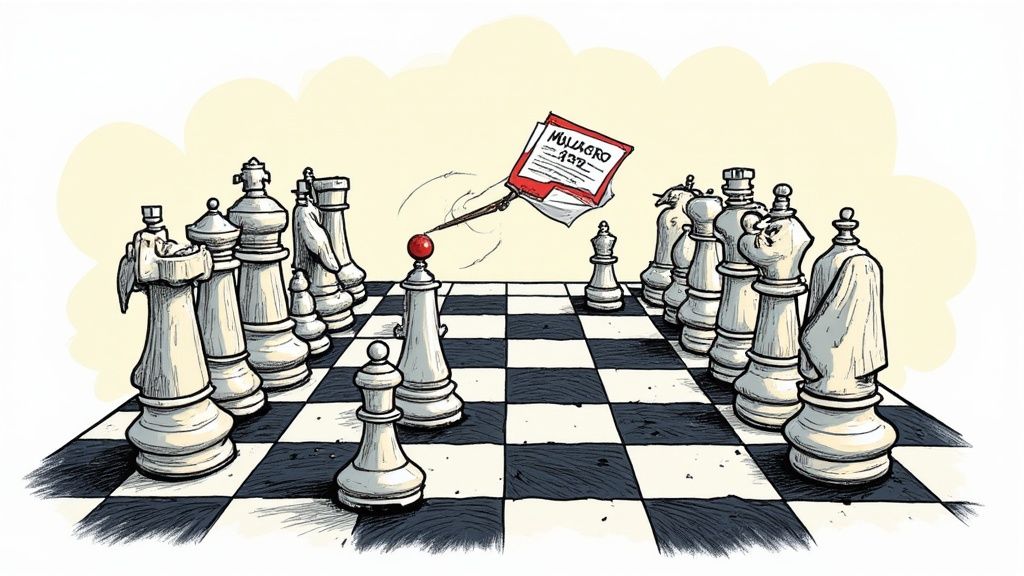The Evolution of Modern Competitive Analysis

Businesses have completely transformed how they analyze their competition. Simple product and price comparisons are no longer enough. Modern competitive analysis requires a deep grasp of market dynamics, competitor strategies, and emerging trends. This shift reflects the growing complexity of markets and the understanding that competitive advantages often come from unexpected places.
From Product Comparisons to Strategic Frameworks
The early days of competitive analysis focused mainly on comparing basic elements like product features, prices, and market share. Take two software companies – a basic analysis would just look at features and costs. But today’s approach examines customer support quality, brand reputation, employee satisfaction, and organizational culture. This gives businesses much richer insights for making key decisions.
The Rise of Intangible Assets
A major shift happened when companies realized the growing importance of intangible assets. Studies in the late 1990s and early 2000s showed that intellectual assets had become crucial drivers of success. The numbers tell the story – intangible assets grew from just 25% of business value in 1978 to over 75% by 2004. Learn more in this detailed research study. Things like brand power, intellectual property, and customer relationships now heavily influence a company’s market position.
Adapting to the Modern Marketplace
Today’s competitive analysis looks at both tangible and intangible factors to build a complete picture. Companies need to understand not just what competitors do, but why they do it. Like chess players, businesses must anticipate future moves, not just react to the current board position. This forward-looking mindset helps companies shape markets instead of just following them.
Integrating Classic and Modern Approaches
Smart companies blend traditional tools like Porter’s Five Forces with advanced data analysis methods. This combination provides deeper competitive insights. While Porter’s model spots industry-wide challenges, data analysis reveals specific weaknesses in competitor strategies. Together, these approaches give companies the full context needed to develop winning strategies that work in real market conditions.
Building Your Competitive Analysis Foundation
A solid competitive analysis framework helps you understand your market position and make smarter business decisions. By studying your competitors’ strategies, strengths, and weaknesses, you can spot opportunities to stand out. This goes beyond basic comparisons – it’s about understanding what drives success in your market.
Core Components of a Winning Framework
Start by mapping out both direct and indirect competitors in your market. Gather key data about their products, positioning, and business approach. This research phase sets up the analysis that follows.
Consider this example: If you’re launching organic dog food, your direct competitors are other organic pet food brands. But don’t forget indirect competitors like traditional dog food companies, homemade food recipes, and raw food diets.
When analyzing competitors, proven frameworks like Porter’s Five Forces or SWOT analysis help organize your findings. Michael Porter’s framework, developed in the 1970-80s, examines five key competitive forces: new market entrants, supplier power, buyer power, substitute products, and existing rivalry. This helps identify both risks and opportunities. Learn more about Porter’s framework here.
Using Frameworks for Strategic Planning
Pick frameworks that match your market and needs. While Porter’s Five Forces works well for understanding industry dynamics, it may miss nuances in specific competitor strategies.
Consider using multiple tools together. Adding a SWOT analysis helps evaluate internal capabilities alongside external factors. But remember – even detailed analysis only has value when you act on the insights.
From Insight to Action
The final crucial step is turning analysis into concrete changes. This could mean adjusting your pricing, updating products, revising marketing, or shifting your business model. Create clear plans to implement your findings and track results over time. Only then does competitive analysis truly drive business growth.
Mastering Competitive Landscape Analysis

A thorough competitive analysis requires more than just identifying competitors. You need to understand market dynamics, track performance metrics, and turn data into actionable strategies. Let’s explore how to develop meaningful insights that drive real business growth.
Creating Detailed Competitor Profiles
Strong competitor analysis starts with detailed profiles of each company in your market. Focus on these key areas:
- Products and Services: Examine their complete product line, noting unique features and gaps
- Marketing Approach: Study their target audience, key messages, and promotional channels
- Price Points: Map out their pricing structure and market positioning
- Key Strengths/Weaknesses: Use SWOT analysis to spot opportunities and risks
Understanding these elements helps you anticipate market shifts and adjust your strategy proactively.
Tracking Meaningful Metrics
Raw market share numbers only tell part of the story. The real insights come from tracking trends over time. Key metrics to monitor include:
- Customer Acquisition Cost (CAC): The investment needed to gain each new customer
- Customer Lifetime Value (CLTV): The total revenue generated per customer
- Online Engagement: Website traffic, social media reach, and content performance
This data reveals deeper patterns in competitor performance and market dynamics. For more insights on competitive analysis frameworks, check out Coresignal’s comprehensive guide.
Identifying Emerging Market Trends
Success requires looking beyond current data to spot future opportunities. Pay attention to:
- Technology Changes: New tools and systems that could reshape your industry
- Customer Behavior: Shifts in how people research and buy products
- Industry Rules: Upcoming regulations that may impact business practices
Staying ahead of these trends helps you adapt your strategy and maintain your competitive edge. Regular trend analysis should be part of your ongoing market research process.
Avoiding Critical Analysis Mistakes
A good competitive analysis framework helps make smart business decisions. However, even the best frameworks can lead to wrong conclusions if not used properly. Let’s explore some common mistakes that can throw off your analysis, even when you have solid tools and data.
Common Blind Spots in Competitive Analysis
Watch out for these frequent blind spots that trip up many analysts:
- Confirmation Bias: Only looking for information that supports what you already believe while ignoring evidence that says otherwise. For example, if you think a competitor is weak in some area, you might miss signs showing they’re strong.
- Too Much Focus on Direct Rivals: Only watching your direct competitors means you could miss threats from new players or substitute products. Remember how Blockbuster missed Netflix’s rise because they weren’t paying attention to new business models.
- Missing Market Changes: Not tracking broader market shifts can quickly make your analysis outdated. New technology or changing customer needs can completely reshape competition.
- Poor Data Analysis: Gathering lots of data isn’t enough. You need to analyze it properly to uncover real insights. Data without a clear way to make sense of it leads to missed opportunities.
Maintaining Objectivity in Your Analysis
Being objective is crucial for good competitive analysis. Here are key ways to stay unbiased:
- Use Clear Methods: Following established frameworks like Porter’s Five Forces, SWOT analysis, and competitor profiles helps keep personal opinions from skewing your work.
- Check Multiple Sources: Look at varied sources, such as customer feedback, industry reports, financial data, and marketing materials, to get a complete picture and avoid relying on biased information.
- Question Your Thinking: Regularly test your assumptions about competitors and markets. Seek different viewpoints and be willing to change your mind when new evidence appears.
Many companies used to rely just on gut feelings about competition. By the mid-2000s, it became clear this wasn’t enough – a more structured approach was needed. Learn more about competitive analysis on Wikipedia.
Learning from Analysis Failures
There’s great value in studying past analysis mistakes, both your own and other companies. Understanding why seemingly logical analysis led to wrong conclusions helps improve your process. These lessons can teach you more than just looking at successes. They reveal weak points in analysis methods and show why adapting to market changes matters. Adding these insights to your competitive analysis framework creates a stronger, more accurate process.
Turning Analysis Into Action

A solid competitive analysis provides crucial insights for business decisions. But insights alone aren’t enough—you need to turn them into real actions that drive growth. Let’s explore practical ways to move from analysis to results.
From Insights to Initiatives
Start by identifying your biggest opportunities and risks. After analyzing competitors, pinpoint areas where you can gain significant advantages or protect against major threats. This focused approach keeps you moving forward on what matters most. For instance, if you spot a competitor’s weak customer service, make improving your own service experience a top priority.
Building an Action Plan
Create a detailed plan that maps out specific steps, deadlines, and team responsibilities. Think of it as your competitive strategy roadmap. A clear plan keeps everyone aligned on goals and makes it easier to track progress. Regular check-ins help you adjust the course when needed.
Setting Up Ongoing Monitoring
Markets change constantly, so one-time analysis isn’t enough. Put systems in place to track important competitor metrics and industry shifts. This might include regular reviews of competitor websites, social media, and market reports. Good monitoring helps you spot changes early and maintain your edge.
Key Performance Indicators (KPIs) and Measurement
Choose relevant KPIs to measure your progress. These metrics show if your competitive strategy is working. For example, if you aim to keep more customers, track metrics like churn rate and customer lifetime value. Review KPIs regularly to stay on target and find areas to improve.
Adapting and Iterating
Markets never stand still. Your initial analysis will need updates as conditions change. Stay ready to adjust strategies based on new competitive insights. If a competitor launches a successful new product, you may need to revise your product plans or marketing messages.
Build support for your recommendations by clearly sharing analysis findings with stakeholders. This transparency helps get buy-in for changes. Keep the momentum going by celebrating wins and tackling challenges head-on. A positive approach keeps teams motivated and shows the real value of competitive analysis.
Future-Proofing Your Competitive Strategy

A solid competitive analysis framework needs regular updates to stay useful. Markets, technology, and customer needs change constantly. Success requires spotting these shifts early and adjusting your analysis methods accordingly.
Key Market Changes to Watch
Major changes like AI, social media, and mobile shopping have reshaped how businesses compete. Companies must now gather data differently and adapt their marketing as buying habits evolve. This highlights why competitive analysis needs to stay current.
Adding New Tools and Methods
Modern analysis requires fresh approaches. AI-powered research tools can speed up data collection, while predictive tools help forecast competitor moves. Just remember – new tools should support, not replace, proven competitive analysis methods.
Keeping Your Core Focus
While staying current matters, don’t chase every new trend. Choose tools and methods that align with your main business goals. This targeted approach ensures your competitive analysis drives real strategic value.
Following Market Leaders
Top companies frequently update how they analyze the competition. They test new methods and share what works. By studying how these leaders adapt, you can find practical ways to improve your framework.
Building for the Future
To create a durable competitive analysis framework, focus on:
- Stay Flexible: Make your framework easy to update as markets change
- Use Smart Tools: Add new analysis capabilities that provide better insights
- Keep Learning: Stay informed about emerging methods and best practices
- Get Practical Results: Ensure analysis leads to clear business actions
Following these guidelines helps build analysis processes that work today and adapt for tomorrow.
Are you selling on Amazon and want to outperform competitors? eStore Factory, winner of three Amazon SPN Awards, specializes in optimizing Amazon listings for better results. Learn how eStore Factory can help your Amazon business.
